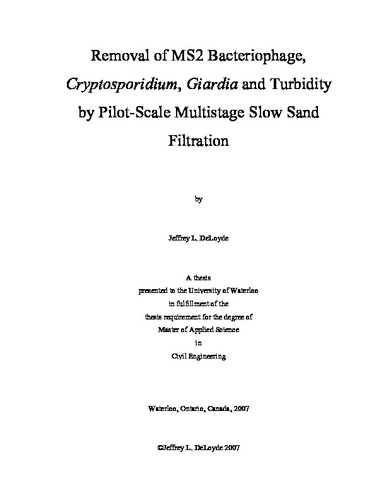| dc.description.abstract | This research aimed to address the knowledge gaps in the literature regarding the removal of waterborne pathogens (viruses and protozoa) by modified multistage slow sand filtration. In the current study, two pilot-scale multistage slow sand filtration systems were operated continuously for over two years. The pilot systems treated agricultural- and urban-impacted raw river water of variable quality with turbidity peaks over 300 NTU and seasonal cold temperatures <2°C.
The first system (Pilot 1) consisted of two independent trains that included pre-ozonation, shallow-bed upflow gravel roughing filtration, and shallow-bed slow sand filtration. Pilot 1 was a pilot-scale version of an innovative, commercially available full-scale system. The second system (Pilot 2) included a full-depth upflow gravel roughing filter, a full-depth slow sand filter, and a second shallow-depth slow sand filter in series. The SSFs of both pilots were operated at high hydraulic loading rates (typically 0.4 m/h) at the upper limit of the literature recommended range (0.05 to 0.4 m/h).
Both pilot systems provided excellent turbidity removal despite the high filtration rates. Effluent turbidity of all multistage SSF pilot systems were within the regulated effluent limits in Ontario for full-scale SSFs (below 1 NTU at least 95% of the time and never exceeded 3 NTU), despite raw water turbidity peaks over 100 NTU. The roughing filters contributed to approximately 60-80% of the full-train turbidity removal, compared to and 20-40% for the slow sand filters. On average, the second slow sand filter in pilot 2 provided almost no additional turbidity removal. The slow sand filter run lengths were short because of frequent high raw water turbidity, with about 50-80% of the runs in the range of 1-3 weeks. To prevent excessive SSF clogging and maintenance, filtration rates should be decreased during periods of high turbidity.
Seven Cryptosporidium and Giardia challenge tests were conducted on the slow sand filters of both pilot systems at varying filtration rates (0.4 or 0.8 m/h), temperatures (2 to 25°C), and biological maturities (4 to 20 months). Removal of oocysts and cysts were good regardless of sand depth, hydraulic loading rate, and water temperature in the ranges tested. Average removals in the SSFs ranged from 2.6 to >4.4 logs for Cryptosporidium oocysts and ranged from >3.8 to >4.5 logs for Giardia cysts. This was consistent with findings in the literature, where oocyst and cyst removals of >4 logs have been reported. Cryptosporidium oocyst removals improved with increased biological maturity of the slow sand filters. At a water temperature of 2°C, average removal of oocysts and cysts were 3.9 and >4.5 logs, respectively, in a biologically mature SSF. Doubling the filtration rate from 0.4 to 0.8 m/h led to a marginal decrease in oocyst removals. Sand depths in the range tested (37-100 cm) had no major impact on oocyst and cyst removals, likely because they are removed primarily in the upper section of slow sand filter beds by straining. In general, good oocyst and cyst removals can be achieved using shallower slow sand filter bed depths and higher filtration rates than recommended in the literature.
There are very few studies in the literature that quantify virus removal by slow sand filtration, especially at high filtration rates and shallow bed depths. There are no studies that report virus removal by slow sand filtration below 10°C. As such, 16 MS2 bacteriophage challenge tests were conducted at varying water temperatures (<2 to >20°C) and filtration rates (0.1 vs. 0.4 m/h) between February and June 2006 on biologically mature slow sand filters with varying bed depths (40 vs. 90 cm). Biologically mature roughing filters were also seeded with MS2.
Average MS2 removals ranged from 0.2 to 2.2 logs in the SSFs and 0.1 to 0.2 logs in the RFs under all conditions tested. Virus removal by slow sand filtration was strongly dependant on hydraulic loading rate, sand depth, and water temperature. Virus removal was greater at a sand depth of 90 cm vs. 40 cm, at an HLR of 0.1 m/h vs. 0.4 m/h, and at warm (20-24°C) vs. cold (<2-10°C) water temperatures when sufficient warm water acclimation time was provided. Increased sand depth likely increased MS2 removal because of greater detention time for predation and greater contact opportunities for attachment to sand grains and biofilms. A lower HLR would also increase MS2 removal by increasing detention time, in addition to decreasing shear and promoting attachment to filter media and biofilms. Greater MS2 removal at warmer water temperatures was attributed to improved biological activity in the filters. Schmutzdecke scraping was found to have only a minor and short-term effect on MS2 removals.
Virus removal can be optimized by providing deep SSF beds and operating at low filtration rates. Virus removal may be impaired in cold water, which could affect the viability of using SSF/MSF at northern climates if communities do not use disinfection or oxidation. As a stand-alone process, slow sand filtration (with or without roughing filtration) may not provide complete virus removal and should be combined with other treatment processes such as disinfection and oxidation to protect human health. | en |

